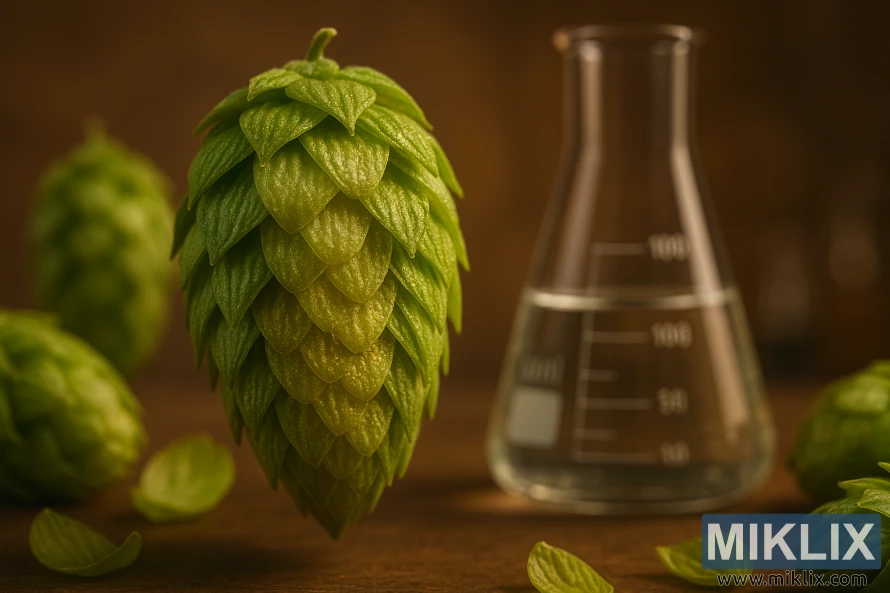Image: Apollo Hops Analysis
Published: July 19, 2025 at 8:58:26 PM UTC
Last updated: September 27, 2025 at 12:38:16 PM UTC
Detailed close-up of Apollo hops showing lupulin glands, cone structure, and lab analysis setup, highlighting brewing potential.
The image captures a striking juxtaposition between the raw vitality of nature and the controlled precision of science, using the Apollo hop cone as its central subject. In the immediate foreground, the hop cone dominates the composition, suspended almost like a specimen under careful observation. Its bracts are layered tightly in overlapping spirals, forming a structure that looks both organic and architectural, a miniature cathedral of nature’s design. The textured surfaces of the scales shimmer subtly under the studio’s warm, directional lighting, revealing not just their verdant green color but also hints of golden resin seeping through the veins. These glistening flecks are the lupulin glands, repositories of the alpha and beta acids that brewers prize for imparting bitterness, stability, and aroma to beer. The cone appears almost alive, as if holding within it a latent energy waiting to be unlocked in the brewing kettle.
Beside it, a clear glass beaker half-filled with a transparent liquid introduces a contrasting yet complementary element. Its sharp lines, precise volume markings, and sterile clarity ground the scene firmly in the realm of science. The beaker’s presence suggests chemical analysis, perhaps an isomerization test or a breakdown of the hop’s alpha acid content to determine its bittering potential. Where the hop cone radiates an untamed, natural complexity, the beaker symbolizes human curiosity and the effort to quantify, measure, and control that complexity. This pairing embodies the relationship at the heart of brewing: an agricultural product transformed by careful, scientific intervention into something greater than the sum of its parts.
The middle ground, though softly blurred, expands the context. Hints of additional hop cones can be seen at the edges of the frame, slightly out of focus, reinforcing the idea that the cone in the spotlight is but one among many carefully cultivated in fields and then selected for deeper scrutiny. Their presence suggests abundance, variety, and the meticulous process of hop selection that brewers undertake when seeking consistency and quality. The leaves scattered loosely on the table contribute a tactile realism, grounding the image in the physical, sensory world—the faint stickiness of resin on fingertips, the sharp herbal fragrance that fills the air when a cone is split open.
In the background, the subdued tones and indistinct forms hint at a laboratory setting, perhaps the benches and instruments of a brewing research facility. There is just enough suggestion of order and apparatus to imply ongoing experiments, yet the details are intentionally softened to maintain focus on the dialogue between hop and beaker in the foreground. The warm brown backdrop evokes both the rustic world of the brewhouse and the refined interior of a laboratory, bridging the gap between craft and science.
The lighting plays a crucial role in shaping the atmosphere. Directed from above and slightly to the side, it falls across the hop cone in a way that emphasizes depth, casting subtle shadows between each bract and highlighting the resinous glow of the lupulin. The beaker reflects this same light, creating clean glints along its glass surface that contrast with the organic irregularities of the hop. This interplay of textures—glossy glass against rough, veined leaf—adds a sense of balance, underscoring the duality of nature and analysis, artistry and chemistry.
The mood conveyed is one of careful study and reverence. The cone is not just an ingredient tossed into a brew kettle, but an object of fascination, deserving of scrutiny down to its smallest gland. Apollo hops, known for their high alpha acid content and clean, resinous bitterness, become here a symbol of both brewing’s agricultural roots and its scientific advancements. The image suggests a brewer or researcher at work, not merely satisfied with tradition but seeking to understand and refine every variable that contributes to the final pint.
Ultimately, this photograph captures the essence of modern brewing: the harmony between field and laboratory, between instinct and data, between the raw gift of nature and the structured pursuit of human knowledge. The Apollo hop cone, bathed in warm light, and the beaker, gleaming with clarity, stand as equal partners in this ongoing dialogue—a reminder that every glass of beer is both a product of the earth and a triumph of science.
The image is related to: Hops in Beer Brewing: Apollo

